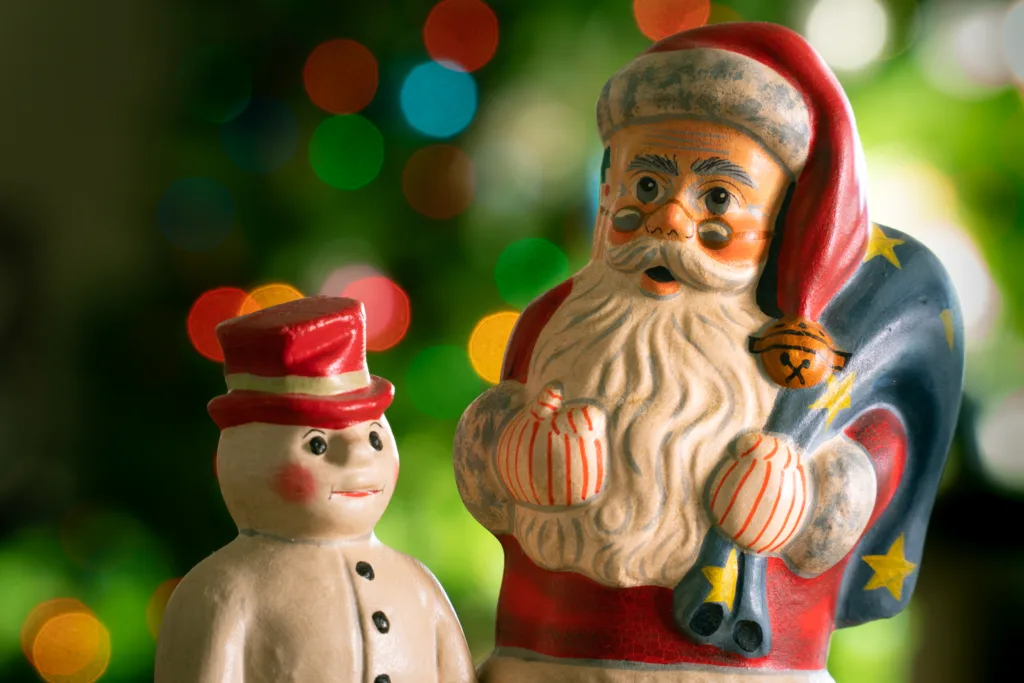Kris Kringle is a beloved figure who is celebrated around the world during the holiday season. His name is derived from the Germanic word “Christkindl”, which translates to “Christ child”. In Germany, Switzerland, and Austria, Kris Kringle is known as the Christkind and traditionally brings gifts to children on Christmas Eve.
In America, Kris Kringle has come to be known as Santa Claus and has become an iconic symbol of Christmas. He is often depicted as a jolly old man in a red suit with a long white beard who rides in a sleigh pulled by reindeer. He delivers presents to all of the good children throughout the world on Christmas Eve.
Kris Kringle also plays an important role in gift-giving traditions around the world. In some countries such as Germany, it is traditional for children to leave their shoes out on December 5th for St. Nicholas Day and receive small gifts from Kris Kringle or his helpers in return. In other places such as Austria and Hungary, it is customary for families to exchange small presents among themselves on December 24th – Christmas Eve – after attending mass or taking part in family festivities.
The origin of Kris Kringle can be traced back centuries ago when stories of a magical gift-bringer began circulating in European folklore. The stories evolved over time to include characters such as Saint Nicholas, Father Christmas, and eventually Santa Claus himself!
So this holiday season don’t forget about Kris Kringle! Whether you call him Santa Claus or Christkindl, he’s been bringing joy and cheer to people all over the world since time immemorial!
What Is the Meaning of Chris Kringle?
Kris Kringle (also known as Christkind in German-speaking countries) is a figure traditionally associated with Christmas. It is believed that Kris Kringle brings gifts to children on Christmas Eve, similar to how Santa Claus does in other parts of the world. The name is derived from the German word Christkindl, which means “Christ Child”. In some areas of the United States, Kris Kringle has become a synonym for Santa Claus and has been used interchangeably with him.

Rules of Kris Kringle
Kris Kringle is a popular Christmas tradition that involves friends and family members buying gifts for each other withut knowing who their gift recipient is. Here are the rules for participating in a Kris Kringle:
1. Gather a group of people who want to participate. This can be family, friends, coworkers, or any other group of people who want to take part in the tradition.
2. Each person draws another person’s name from a hat (or any other container) without revealing whose name they have chosen.
3. Each person buys a gift for the person whose name they have drawn, while keeping it secret from the rest of the group.
4. On an agreed-upon date, all of the gifts are exchanged and everyone’s Secret Santa / Kris Kringle is revealed!
5. Everyone opens their gifts and shares in the joy of giving and receiving with their friends and family!
The Religious Affiliation of Kris Kringle
Kris Kringle is a figure traditionally associated with Christmas and gift-giving, originating in Germany and other parts of Europe. He is often seen as a representation of Saint Nicholas, the patron saint of children in Christianity, although some cultures recognize him as being related to other religious figures such as Father Christmas or the Christ Child. In some countries he is also known by his original name, Christkindl. Therefore, while Kris Kringle has no direct religious affiliation, he is most closely associated with Christianity.
The Origin of Kris Kringle
Kris Kringle, also known as Santa Claus, originates from the German tradition of Kristkindl. This term is derived from the German word Kristkind, meaning “Christ Child”. The first documented use of Kris Kringle in English was in 1830 when Pennsylvania Dutch settlers brought the tradition to America. Since then, Kris Kringle has become a part of popular culture and is celebrated around the world during the Christmas holiday season.

The Meaning of Kringle in English
Kringle is a Scandinavian pastry, a Nordic variety of pretzel. It is an elliptically shaped sweet pastry made from layers of buttery dough and filled with sugar, nuts and spices. Kringles are usually decorated with icing, drizzled chocolate or fruit toppings. They can be bought in many stores throughout Scandinavia and in some parts of Europe, as well as online. Kringles are often served with coffee or tea and make a delightful snack or dessert.
Giving a Secret Santa Gift
Giving a Secret Santa gift is a fun and exciting way to share the holiday spirit with your friends, family, or coworkers. Here are some tips to help make sure your gift-giving experience is a success:
1. Before the drawing of names, set a budget for the gifts so everyoe knows how much to spend. This will prevent feelings of unfairness or resentment.
2. Once you’ve drawn names, communicate with your giftee to get an idea of what they might like as a gift. Ask them if they have any special interests or hobbies that could give you some ideas for gifts.
3. Choose your gift carefully and with thoughtfulness. Make sure it fits within the budget you’ve set and make sure it’s something that’s meaningful and useful for your giftee. It can also be fun to include a personalized note or card along with the gift so your giftee knows it’s from you!
4. Wrap up the gift in festive packaging and make sure to keep it a surprise until it’s opened!
5. Finally, when it comes time to reveal who gave which gifts, have everyone guess who their Secret Santa was! This can be lots of fun and add another level of excitement to the exchange!
Should Secret Santa Be Revealed?
The answer to this question depends on the group and the rules they have set for their Secret Santa exchange. Generally speaking, it is best for everyone to remain anonymous or for everyone to reveal themselves rather than some revealing themselves and others not. This can help create a sense of fairness and equality aong all participants in the exchange. If anonymity is desired, it is important for all participants to respect each other’s wishes, as revealing one another’s identity could be seen as disrespectful or disruptive to the exchange. Ultimately, it is up to the group to decide whether they want anonymity or if they prefer that everyone reveals their identity during the exchange.
Gift Giving Rules
Gift rules are guidelines to help ensure that gift giving is meaningful, appropriate and enjoyable for both the giver and receiver. Here are five essential rules for successful gift giving:
1) Consider the recipient’s interests: Before selecting a gift, spend some time considering what the recipient might enjoy. It’s important to think about their hobbies, passions and lifestyle so that you can choose something they will truly appreciate.
2) Don’t add a small gift to a big one: If you are gifting someone an expensive item like jewelry or electronics, don’t try to fill in the package with smaller items. It makes it look like you didn’t put much thought into it.
3) Gift experiences rather than things: Instead of buying physical gifts which can beome clutter, consider gifting experiences like a cooking class or tickets to a show that they would enjoy.
4) Gift cards are not bad: While giving someone cash directly may seem impersonal, gifting them with a store card or prepaid card can be very thoughtful if you know what type of store they enjoy shopping at.
5) Spend more on others than on yourself: The art of gift giving should always be about the other person, not about yourself. Try to focus on making sure that your gifts make the recipient feel special and appreciated – not just how much money you spent on them.

The Real Name of Kris Kringle
Kris Kringle’s real name is Saint Nicholas, and he has been a part of Christmas tradition for centuries. Saint Nicholas was a 4th-century Greek Christian bishop from the town of Myra in modern-day Turkey. He was known for his generous gifts to the poor, and his kindness and generosity led to stories of him being the secret gift-giver of Christmas. He later became known as Santa Claus in the English-speaking world, and eventually became known as Kris Kringle in some parts of Europe.
The Real-Life Inspiration Behind Santa Claus
Santa Claus is based on the real person of St. Nicholas of Myra, a 4th century Bishop who lived in what is now modern-day Turkey. Through historical records and research, Professor Adam English of Campbell University in North Carolina has pieced together a comprehensive biography of St. Nicholas in his book, The Saint Who Would Be Santa Claus: The True Life and Trials of Nicholas of Myra.
St. Nicholas was known for his generous spirit and acts of kindness toward children, which became the basis for many modern-day Christmas traditions. He was said to have given away his wealth to help the poor and needy, provided dowries to young women so they could marry, and even saved three innocent men from execution by bribing a wicked judge. It was thse characteristics that inspired the figure of Santa Claus as we know him today – jolly and generous, with a knack for gift-giving – with much folklore surrounding his travels on Christmas Eve to bring presents to children around the world.
The Meaning of ‘Kringle’ in German
Kringle (or Christkindl) is a German word meaning “Christ child” and is used to refer to Father Christmas or Santa Claus. It is believed that the baby Jesus brings presents during the Christmas season, hence the association with Santa Claus. The word can also be used to describe a type of pastry usually made from sweetened dough, which is popular in Germany during the festive season.
Wisconsin’s Famous Kringle
Wisconsin is known for its Kringle, a traditional Scandinavian pastry made with flaky layers of dough, filled with various fruit or nut-based fillings. The pastries are often then decorated with icing or nuts. The Kringle became the official state pastry of Wisconsin on June 30, 2013 and is widely celebrated in the Badger State. In addition to being popular among locals and visitors alike, some Wisconsin distilleries even make a Kringle cream liqueur that combines Wisconsin cream, rum, sugar, and natural Kringle flavor.
The Country That Calls Santa Kris Kringle
Kris Kringle is a nickname for Santa Claus that is mainly used in the United States and Canada. The name originates from the German word Christkind, which means “Christ child”. In these countries, it’s a popular custom to leave milk and cookies out on Christmas Eve to keep Kris Kringle going as he delivers gifts to children around the world.
Are Kringles a Wisconsin Tradition?
Yes, Kringles are a Wisconsin thing! Kringles are an oval-shaped pastry that originated in Denmark but have been a Racine County tradition in Wisconsin since the mid-19th century. The flaky, buttery pastry is made with layers of dough rolled out thin and folded over multiple times before being filled with fruit or nut filling. Kringle has even been named the official state pastry of Wisconsin in 2013. It can be found in many stores across the state and is often served at events and celebrations.

Conclusion
In conclusion, Kris Kringle is a variation of the German Christkind or Christkindl, which is a traditional gift-bringer at Christmas-time in certain European countries. The name was first documented in English in 1830 thanks to the immigration of Pennsylvania Dutch settlers. Today, Kris Kringle is typically used as a synonym for Santa Claus and can also refer to a group activity where people anonymously exchange gifts with each other. No matter how you choose to celebrate it, Kris Kringle remains an important part of the holiday season.
